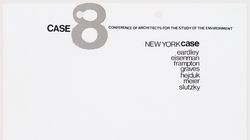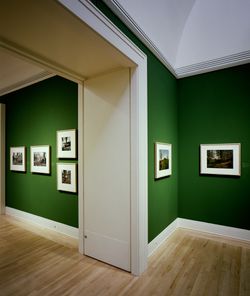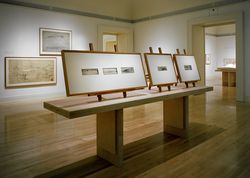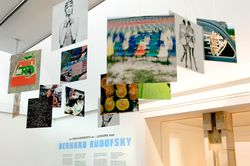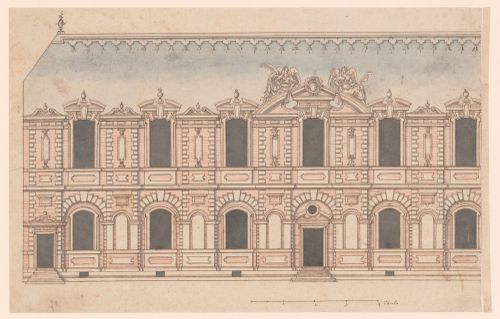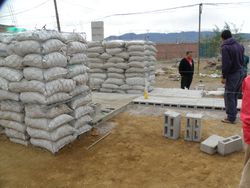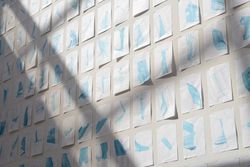dessins, documents textuels
AP178.S1.1988.PR07.SS5.044.2
Description:
Original file title : Chiado (P.Porm) Docum Fases iniciais This file includes a article of the Archives d'Architecture Moderne about Lisbon.
1989-1993
Correspondence, preliminary plans, studies, proposals, and notes, Bloco B, Reconstrução do Chiado, Lisbon (folder 2 of 4)
Actions:
AP178.S1.1988.PR07.SS5.044.2
Description:
Original file title : Chiado (P.Porm) Docum Fases iniciais This file includes a article of the Archives d'Architecture Moderne about Lisbon.
dessins, documents textuels
1989-1993
Susanne Bauer, chercheure en résidence 2016, présente ses recherches : Les débats théoriques dans le monde de l’architecture aux États-Unis depuis le début des années 1960 portaient souvent sur des questions d’analyse formelle de l’espace architectural et, plus largement, sur l’état de la situation de l’architecture et sur ses perspectives d’avenir. Certains de ces(...)
Maison Shaughnessy
21 juillet 2016, 18h
Séminaire de chercheur en résidence : Susanne Bauer
Actions:
Description:
Susanne Bauer, chercheure en résidence 2016, présente ses recherches : Les débats théoriques dans le monde de l’architecture aux États-Unis depuis le début des années 1960 portaient souvent sur des questions d’analyse formelle de l’espace architectural et, plus largement, sur l’état de la situation de l’architecture et sur ses perspectives d’avenir. Certains de ces(...)
Maison Shaughnessy
En réponse à une commande du CCA, trois photographes contemporains ont consacré six ans à l’interprétation de l’œuvre de Frederick Law Olmsted (1822-1903), qui a marqué l’histoire de l’architecture du paysage en Amérique du Nord. *Frederick Law Olmsted en perspective : Photographies de Robert Burley, Lee Friedlander et Geoffrey James* présente 155 photographies issues de(...)
Salles principales
16 octobre 1996 au 2 février 1997
Frederick Law Olmsted en perspective : Photographies de Robert Burley, Lee Friedlander et Geoffrey James
Actions:
Description:
En réponse à une commande du CCA, trois photographes contemporains ont consacré six ans à l’interprétation de l’œuvre de Frederick Law Olmsted (1822-1903), qui a marqué l’histoire de l’architecture du paysage en Amérique du Nord. *Frederick Law Olmsted en perspective : Photographies de Robert Burley, Lee Friedlander et Geoffrey James* présente 155 photographies issues de(...)
Salles principales
Série(s)
CIAM IV, CIRPAC and London
AP112.S1
Description:
The series contains seven bands of negatives, divided into groups of two and three negatives a band. The first five bands document the 4th Congrès International d'Architecture Moderne (CIAM) held on board the SS Patris II from 29 July to 13 August 1933, as it travelled between Marseilles, France, and Athens, Greece, and then returned. The conference, themed "The Functional City", presented and discussed the results of an analysis of more than thirty cities, and sought to establish new principles in urban planning. Sise participated at the conference as the Canadian delegate and presented the city of Los Angeles, California. The resolutions adopted at the conference were published for the first time in November under the title "Constatations du quatrième CIAM". These findings formed the base of the Charte d'Athenès written by Le Corbusier in 1941. The negatives show some of the participants of the conference including: Le Corbusier (1887-1965), from the French delegation; László Moholy-Nagy (1895-1946), from the German delegation, who was in charge of filming the presentations; Alvar Aalto (1898-1976), representing Finland; and the painter Fernand Léger (1881-1955), also from the French delegatation, who presented on the importance of colour in architecture. The two other bands of negatives provide evidence of Sise's attendance at Comité International pour la Résolution des Problèmes d'Architecture Contemporaine (CIRPAC), held in May 1934 at the Royal Institute of British Architects in London, England, to establish the program for the next CIAM (1). They also show his meeting in London with Georges Braque during the summer of the same year. (1) Eric Mumford states in "The CIAM Discourse on Urbanism, 1928-1960" that Le Corbusier did not participate at this conference (p. 92). _____________________ La série contient des bandes de négatifs, qui contiennent soit deux, soit trois images, et sont au nombre de sept. Les cinq premières bandes documentent le IVe Congrès International d'Architecture Moderne (CIAM) tenu à bord du SS Patris II du 29 juillet au 13 août 1933, entre Marseilles, France et Athènes, Grèce, à Athènes même, et sur le même bateau de croisière durant le retour à Marseilles. Le Congrès, qui se déroulait autour du thème de "The functional city", consistait en la communication des résultats de l'analyse de plus de trente villes et l'objectif visait à établir de nouveaux principes d'urbanisme. Hazen Sise participait au Congrès à titre de délégué du Canada et présenta la ville de Los Angeles, Californie. Les résolutions prises lors du Congrès ont été publiées pour la première fois au mois de novembre suivant sous le titre de "Constatations du quatrième CIAM". Ces "Constatations" seront ensuite à la base de la Charte d'Athènes que Le Corbusier rédigea en 1941. Les clichés montrent quelques-uns des participants au Congrès, dont Le Corbusier (1887-1965), de la délégation française, alors qu'il faisait une communication; László Moholy-Nagy (1895-1946), de la délégation allemande, à qui on avait confié la tâche de filmer les exposés; Alvar Aalto (1898-1976), représentant la Finlande; et le peintre Fernand Léger (1881-1955), délégué de la France, qui présenta un discours à l'attention des architectes au sujet de l'importance de la couleur en architecture. Les deux autres bandes de négatifs témoignent de la présence de Sise au (Comité International pour la Résolution des Problèmes d'Architecture Contemporaine (CIRPAC) à Londres, Angleterre, tenu en mai 1934 au Royal Institute of British Architects pour établir le programme du prochain CIAM (1) et de sa rencontre à Londres avec Georges Braque durant l'été de la même année. (1) Eric Mumford affirme cependant dans "The CIAM Discourse on Urbanism, 1928-1960" que Le Corbusier n'a pas participé à ce congrès (p. 92).
1933-1934
CIAM IV, CIRPAC and London
Actions:
AP112.S1
Description:
The series contains seven bands of negatives, divided into groups of two and three negatives a band. The first five bands document the 4th Congrès International d'Architecture Moderne (CIAM) held on board the SS Patris II from 29 July to 13 August 1933, as it travelled between Marseilles, France, and Athens, Greece, and then returned. The conference, themed "The Functional City", presented and discussed the results of an analysis of more than thirty cities, and sought to establish new principles in urban planning. Sise participated at the conference as the Canadian delegate and presented the city of Los Angeles, California. The resolutions adopted at the conference were published for the first time in November under the title "Constatations du quatrième CIAM". These findings formed the base of the Charte d'Athenès written by Le Corbusier in 1941. The negatives show some of the participants of the conference including: Le Corbusier (1887-1965), from the French delegation; László Moholy-Nagy (1895-1946), from the German delegation, who was in charge of filming the presentations; Alvar Aalto (1898-1976), representing Finland; and the painter Fernand Léger (1881-1955), also from the French delegatation, who presented on the importance of colour in architecture. The two other bands of negatives provide evidence of Sise's attendance at Comité International pour la Résolution des Problèmes d'Architecture Contemporaine (CIRPAC), held in May 1934 at the Royal Institute of British Architects in London, England, to establish the program for the next CIAM (1). They also show his meeting in London with Georges Braque during the summer of the same year. (1) Eric Mumford states in "The CIAM Discourse on Urbanism, 1928-1960" that Le Corbusier did not participate at this conference (p. 92). _____________________ La série contient des bandes de négatifs, qui contiennent soit deux, soit trois images, et sont au nombre de sept. Les cinq premières bandes documentent le IVe Congrès International d'Architecture Moderne (CIAM) tenu à bord du SS Patris II du 29 juillet au 13 août 1933, entre Marseilles, France et Athènes, Grèce, à Athènes même, et sur le même bateau de croisière durant le retour à Marseilles. Le Congrès, qui se déroulait autour du thème de "The functional city", consistait en la communication des résultats de l'analyse de plus de trente villes et l'objectif visait à établir de nouveaux principes d'urbanisme. Hazen Sise participait au Congrès à titre de délégué du Canada et présenta la ville de Los Angeles, Californie. Les résolutions prises lors du Congrès ont été publiées pour la première fois au mois de novembre suivant sous le titre de "Constatations du quatrième CIAM". Ces "Constatations" seront ensuite à la base de la Charte d'Athènes que Le Corbusier rédigea en 1941. Les clichés montrent quelques-uns des participants au Congrès, dont Le Corbusier (1887-1965), de la délégation française, alors qu'il faisait une communication; László Moholy-Nagy (1895-1946), de la délégation allemande, à qui on avait confié la tâche de filmer les exposés; Alvar Aalto (1898-1976), représentant la Finlande; et le peintre Fernand Léger (1881-1955), délégué de la France, qui présenta un discours à l'attention des architectes au sujet de l'importance de la couleur en architecture. Les deux autres bandes de négatifs témoignent de la présence de Sise au (Comité International pour la Résolution des Problèmes d'Architecture Contemporaine (CIRPAC) à Londres, Angleterre, tenu en mai 1934 au Royal Institute of British Architects pour établir le programme du prochain CIAM (1) et de sa rencontre à Londres avec Georges Braque durant l'été de la même année. (1) Eric Mumford affirme cependant dans "The CIAM Discourse on Urbanism, 1928-1960" que Le Corbusier n'a pas participé à ce congrès (p. 92).
Series
1933-1934
Le rapport révolutionnaire établi entre bâtiment et paysage, conçus ensemble selon des idéaux américains particuliers est au centre de Frank Lloyd Wright : Inventer un paysage américain, 1922-1932. Avec cette exposition, le CCA reconstitue cinq projets visionnaires qui ne devaient représenter rien de moins qu’un nouveau paysage, intégrant sur une vaste échelle terrain,(...)
Salles principales
18 juin 1996 au 29 septembre 1996
Frank Lloyd Wright : inventer un paysage américain, 1922-1932
Actions:
Description:
Le rapport révolutionnaire établi entre bâtiment et paysage, conçus ensemble selon des idéaux américains particuliers est au centre de Frank Lloyd Wright : Inventer un paysage américain, 1922-1932. Avec cette exposition, le CCA reconstitue cinq projets visionnaires qui ne devaient représenter rien de moins qu’un nouveau paysage, intégrant sur une vaste échelle terrain,(...)
Salles principales
Projet
Village housing for CIAM X
AP140.S2.SS1.D9
Description:
File documents an unexecuted project, presented at CIAM X (Congrès internationaux d'architecture moderne), for village housing, England, United Kingdom. Material in this file was produced in 1955 and probably after. File contains presentation drawings, textual records, and photographic materials.
circa 1955
Village housing for CIAM X
Actions:
AP140.S2.SS1.D9
Description:
File documents an unexecuted project, presented at CIAM X (Congrès internationaux d'architecture moderne), for village housing, England, United Kingdom. Material in this file was produced in 1955 and probably after. File contains presentation drawings, textual records, and photographic materials.
File 9
circa 1955
Les enseignements de Bernard Rudofsky est la première rétrospective qui examine la vie et l’œuvre de l’architecte, designer et critique controversé, dont les constructions, les expositions et les concepts de mode ont remis en question les idées mêmes de confort et de culture dans le monde occidental. L’exposition jette un regard sur la diversité des contributions d’un(...)
Salles principales
4 juillet 2007 au 30 septembre 2007
Les enseignements de Bernard Rudofsky
Actions:
Description:
Les enseignements de Bernard Rudofsky est la première rétrospective qui examine la vie et l’œuvre de l’architecte, designer et critique controversé, dont les constructions, les expositions et les concepts de mode ont remis en question les idées mêmes de confort et de culture dans le monde occidental. L’exposition jette un regard sur la diversité des contributions d’un(...)
Salles principales
Elevation of a palace façade
DR1970:0003
Description:
This drawing shows an exterior of a residential building. The artist uses color to suggest the materials used in construction; blue-grey for the pitched slate roof, brown for masonry details and architectural sculpture, and red striations for brickwork. This combination of materials was common in early modern France, where a play on color and materiality enlivened the façades of well-known royal edifices including the chateaux of Fontainebleau and Saint-Germain-en-Laye. As with the construction technique that interwove stone with brick, the architectural style depicted in the drawing combines traditional French ideas about building with classicizing elements imported to France via Italian artists and architects as well as through printed translations of Vitruvius’s 'De architectura' and Sebastiano Serlio’s architectural treatise. The inclusion of masonry rustication and the decorative urns that punctuate the roofline suggest a knowledge of classicizing trends in architectural ornament and a familiarity with the œuvre of artists working in the circle of the first and second Écoles de Fontainebleau. The structure’s elongated form suggests a gallery and the organization of the façade borrows the combination of slightly protruding vertical bays and long horizontal registers that characterizes Pierre Lescot’s wing of the Louvre, a project that would have been well-known in court circles in the latter half of the sixteenth century. Similarly, the two winged allegorical figures flanking the central pediment are reminiscent of Jean Goujon’s sculptural additions to the Lescot wing. In the Canadian Centre for Architecture’s drawing both figures hold palms, but the artist omitted any further identifying attributes, perhaps – along with the empty niches – as an invitation for the patron to imagine his or her own thematic program for the project.
first quarter of the 16th century
Elevation of a palace façade
Actions:
DR1970:0003
Description:
This drawing shows an exterior of a residential building. The artist uses color to suggest the materials used in construction; blue-grey for the pitched slate roof, brown for masonry details and architectural sculpture, and red striations for brickwork. This combination of materials was common in early modern France, where a play on color and materiality enlivened the façades of well-known royal edifices including the chateaux of Fontainebleau and Saint-Germain-en-Laye. As with the construction technique that interwove stone with brick, the architectural style depicted in the drawing combines traditional French ideas about building with classicizing elements imported to France via Italian artists and architects as well as through printed translations of Vitruvius’s 'De architectura' and Sebastiano Serlio’s architectural treatise. The inclusion of masonry rustication and the decorative urns that punctuate the roofline suggest a knowledge of classicizing trends in architectural ornament and a familiarity with the œuvre of artists working in the circle of the first and second Écoles de Fontainebleau. The structure’s elongated form suggests a gallery and the organization of the façade borrows the combination of slightly protruding vertical bays and long horizontal registers that characterizes Pierre Lescot’s wing of the Louvre, a project that would have been well-known in court circles in the latter half of the sixteenth century. Similarly, the two winged allegorical figures flanking the central pediment are reminiscent of Jean Goujon’s sculptural additions to the Lescot wing. In the Canadian Centre for Architecture’s drawing both figures hold palms, but the artist omitted any further identifying attributes, perhaps – along with the empty niches – as an invitation for the patron to imagine his or her own thematic program for the project.
Arturo Ortiz Struck décrit les frontières de la construction légale et autorisée dans le contexte de Mexico :« Afin de nous forger une opinion critique sur la production d’espace et d’architecture dans cet environnement, nous devrions commencer par deux principes fondamentaux. Le premier établit que les espaces reflètent qui nous sommes, et ils traduisent nos habitudes(...)
Théâtre Paul-Desmarais
10 mai 2012 , 19h
L'enseignement de... Mexico : Arturo Ortiz Struck
Actions:
Description:
Arturo Ortiz Struck décrit les frontières de la construction légale et autorisée dans le contexte de Mexico :« Afin de nous forger une opinion critique sur la production d’espace et d’architecture dans cet environnement, nous devrions commencer par deux principes fondamentaux. Le premier établit que les espaces reflètent qui nous sommes, et ils traduisent nos habitudes(...)
Théâtre Paul-Desmarais
Quand Gordon Matta-Clark se procure les titres de propriété et la documentation d’une douzaine de petites parcelles non occupées à New York entre 1974 et 1977 (qui, en 1992, ont fait l’objet d’une exposition intitulée Reality Properties: Fake Estates), il n’a pas d’intention précise – autre que sa conviction suivant laquelle « l’existence de lots vacants et sous-utilisés(...)
Théâtre Paul-Desmarais
22 septembre 2016, 18h
Nicholas de Monchaux : Local Code
Actions:
Description:
Quand Gordon Matta-Clark se procure les titres de propriété et la documentation d’une douzaine de petites parcelles non occupées à New York entre 1974 et 1977 (qui, en 1992, ont fait l’objet d’une exposition intitulée Reality Properties: Fake Estates), il n’a pas d’intention précise – autre que sa conviction suivant laquelle « l’existence de lots vacants et sous-utilisés(...)
Théâtre Paul-Desmarais
